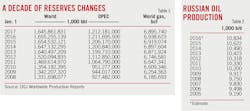Worldwide crude oil reserves down, production holds steady
Oil & Gas Journal's annual look at worldwide proved crude oil and natural gas reserves shows reductions in reserves, reflecting lower commodity prices that have slowed drilling and reduced operating economics.
Estimated worldwide crude oil and condensate reserves decreased to 1.645 trillion bbl from 1.655 trillion in last year's survey (OGJ, Dec. 7, 2015, p. 20). Gas reserves total 6.89 quadrillion cu ft, down from 6.94 quadrillion cu ft reported a year ago. The Western Hemisphere contributed most of the declines.
The published reserves figures rely on survey responses and official updates released by individual countries, which are not provided every year in many cases. OGJ changes its estimate for a particular country only when it receives evidence that a change is in order. Therefore, in a given reserves summary, a year-to-year change-or lack thereof-may not necessarily reflect a change that applies to the calendar year alone.
Worldwide crude oil and condensate production in 2016 will hold steady, OGJ forecasts, averaging 78.33 million b/d vs. a 2015 average of 78.38 million b/d, with higher crude production from the Organization of Petroleum Exporting Countries offsetting non-OPEC declines.
Reserves changes
China's proved crude oil reserves increased to 25.62 billion bbl in 2015 from 25.13 billion bbl a year earlier, according to the 2016 China Mineral Resources Report. China also has raised its gas reserves estimate to 183.42 tcf.
Geoscience Australia (GA) reported that Australia's proved crude oil and condensate reserves totaled 1.82 billion bbl at yearend 2014, up from 1.19 billion bbl estimated at yearend 2012. Gas reserves also have risen to 70.23 tcf from 30.4 tcf reported in the previous survey.
The 2015-16 Indian Petroleum & Natural Gas Statistics report revised down current and historical Indian crude oil and natural gas reserves. Now the country's reserves of crude oil as of Apr. 1 were 4.62 billion bbl compared with last year's total of 4.73 billion bbl. Gas reserves as of Apr. 1 were 43.34 tcf compared with 44.21 tcf on the same date last year.
This year OGJ raised Myanmar's crude oil and gas reserves to 139 million bbl and 22.5 tcf, respectively, based on the claims of the Minister of Energy of Myanmar.
The latest figures available from the Norwegian Petroleum Directorate show an increase in Norway's proved oil reserves. Crude and condensate reserves are estimated to have increased to 6.61 billion bbl vs. the previous estimate of 5.14 billion bbl.
The UK's crude reserves declined to 2.56 billion bbl from 2.75 billion bbl. Gas reserves reached 7.32 tcf, up from 7.25 tcf a year ago, according to the recent estimates from the Oil & Gas Authority.
Estimates of oil and gas reserves in Denmark slipped substantially from a year ago, as part of last year's reserves has been transferred to the category contingent resources due to uncertainty surrounding the major development of Tyra field installations and Hejre field.
OGJ kept Russia's proved oil reserves at 80 billion bbl. However, according to the Ministry of Natural Resources & Environment of Russia, the country's recoverable oil reserves of A+B+C1+C2 status amount to 210 billion bbl in 2015.
Petroleos Mexicanos (Pemex) reports that Mexico's proved crude oil reserves have decreased 21.3% to about 7.64 billion bbl and gas reserves have fallen about 17.2% to 12.65 tcf.
Compared with a year ago, crude reserves in Brazil decreased 19.6% to 12.99 billion bbl and gas reserves declined 8.7% to 15.18 tcf, according to Brazil's National Petroleum Agency.
According to the Argentine Petroleum & Gas Institute, Argentina's reserves estimate for oil decreased 8%, while its gas reserves are down 4.7%. Peru reported a decrease of 30% in oil reserves to 473 million bbl and a decrease of 3.6% in gas reserves.
OGJ also decreased proved oil reserves of Trinidad and Tobago to 242.98 million bbl, based on a speech delivered by the country's Minister of Energy on Oct. 7. As known, the country's gas reserves estimate, which was down 1 tcf in 2015, was audited by Ryder Scott.
OPEC reserves
The reserves figures reported here for OPEC members are referenced from the organization's most recent Annual Statistical Bulletin.
With the addition of Gabon and Indonesia this year, total OPEC proved crude oil reserves reached 1.212 trillion bbl. The share of the world's oil reserves in OPEC now stands at 73.6%.
Most OPEC members' oil reserves have declined compared with a year earlier, while Venezuela's oil reserves increased by 925 million bbl to 300.87 billion bbl and Iran's oil reserves increased by 870 million bbl to 158.4 billion bbl.
The estimate of gas reserves has been 0.5% lower to 3.44 quadrillion cu ft. OPEC controls 49.95% of total global natural gas reserves.
US, Canadian reserves
The US Energy Information Administration is scheduled this month to release the yearend 2015 estimates of US crude oil and gas reserves. As OGJ went to press last week, these new reserves figures are not accessible and the figures updated in this report are OGJ's estimates, which are based on recent reserves changes indicated by OGJ150.
OGJ estimates that, as of yearend 2015, US proved crude oil and lease condensate reserves totaled 35.27 billion bbl, down 11.6% from the prior year. Dry gas reserves decreased 20% to 293 tcf.
The latest estimate reported by the Canadian Association of Petroleum Producers shows a 0.6% decline in Canadian oil reserves to 169.7 billion bbl. Conventional crude oil and condensate reserves in Canada are 4.32 billion bbl compared with last year's 4.55 billion bbl. The country's oil sands reserves now total 165.38 billion bbl, down from last year's 166.31 billion bbl.
According to CAPP, Canadian proved gas reserves rose 9.3% from a year ago to 77 tcf, reflecting the increase in gas from British Columbia.
Oil production
OPEC crude oil production is estimated to have climbed 3% this year to 33.26 million b/d. Iran-relieved of sanctions since January-is expected to ramp up by over 600,000 b/d this year, while Iraq will add nearly 400,000 b/d compared with 2015.
Since the end of 2014, output from Saudi Arabia, Iraq, and Iran-OPEC's three largest producers-has soared by 2.7 million b/d.
Eastern Europe and the former Soviet Union were the second growing regions with 2016 crude and condensate production up an estimated 1.3% from 2015. Russia's estimated oil production this year averaged 10.83 million b/d, up from 10.62 million b/d in 2015.
Led by the US, Western Hemisphere is the region to have posted the largest production decline this year. US crude oil production is estimated to decline nearly 6.5% this year to 8.8 million b/d. Canada production will decline 2.6%. Noticeably, NGL production in the US and Canada is growing rapidly, partly offsetting the decline in crude oil production.
Western European production holds steady this year. Norwegian oil production is expected to be largely unchanged from the previous year. UK production will increase 9.4% from last year due to fields that recently came online.
Combined production in the Asia-Pacific region averages an estimated 7.35 million b/d this year, down 3.5% from a year ago. Oil production from China is expected to fall off 250,000 b/d this year.
About the Author
Conglin Xu
Managing Editor-Economics
Conglin Xu, Managing Editor-Economics, covers worldwide oil and gas market developments and macroeconomic factors, conducts analytical economic and financial research, generates estimates and forecasts, and compiles production and reserves statistics for Oil & Gas Journal. She joined OGJ in 2012 as Senior Economics Editor.
Xu holds a PhD in International Economics from the University of California at Santa Cruz. She was a Short-term Consultant at the World Bank and Summer Intern at the International Monetary Fund.
Laura Bell-Hammer
Statistics Editor
Laura Bell-Hammer has been the Statistics Editor for the Oil & Gas Journal since 1994. She was the Survey Editor for two years prior to her current position with OGJ. While working with OGJ, she also was a contributing editor for Oil & Gas Financial Journal. Before joining OGJ, she worked for Vintage Petroleum in Tulsa, gaining her oil and gas industry knowledge.



